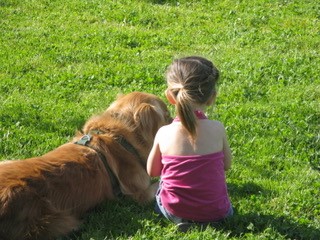Helping Children Navigate Grief and Loss
 How children react to grief will vary - even in the same household - and will be affected by a number of factors including their own relationship with their pet, their previous experiences with illness or death, the attitudes of those around them, the family value and belief system, their own development and personality, and their ages.
How children react to grief will vary - even in the same household - and will be affected by a number of factors including their own relationship with their pet, their previous experiences with illness or death, the attitudes of those around them, the family value and belief system, their own development and personality, and their ages.
Parents play a key role in helping to normalize the grief process for their children. It’s important to acknowledge and validate the loss as well as the feelings that each family member may experience.
Very young children aren’t equipped to fully understand death and grief concepts. They certainly feel sadness and loss, and they generally take their cues from the adults around them about normal, healthy response to loss. Your actions and behaviors will help to guide them, teach them, and reassure them.
It’s natural to want to protect your child from the sadness, worry, and anxiety of serious illness and death. But hiding the truth can backfire and open the door to misinformation. It’s important to be as open as possible. Death is a natural experience, and it can be an important opportunity for discussion. And you can allow your child to participate in the decision-making process where appropriate.
One of the best ways to help your child cope with the loss of a pet is by talking openly about it. Children benefit from honesty, open expression, reassurance, and discussion about loss and sadness. Whenever possible, stick to the facts. You can explain that your pet has died. You can assure your child that their pet is no longer in pain or suffering. And you can let children know that their beloved friend or family member will not be coming back. It’s very important to use language that doesn’t create confusion or fear. Always avoid euphemisms like “put to sleep” as children may begin to fear going to sleep themselves. And if you talk about your pet being “sick”, be sure to fully explain that not all sickness results in death.
Children are naturally inquisitive, so give them plenty of time to ask questions and express their feelings. Know that what may seem trivial to an adult can be significant to a child. A strong reaction from a seemingly unrelated event - like a flood of tears released by a broken crayon for example - may be a grief response. So be prepared for seemingly erratic outbursts. Each of us grieves uniquely, and children are no exception. They are learning to understand their feelings. And they may hold in their feelings until they feel safe to express them.
Mirroring a healthy response to grief, respecting each other’s process, and talking with patience and clarity will help everyone in the family.
Never try to “replace” a pet. No loved one can ever be replaced. Just like you, your child needs time to work through their sadness. They will let you know when they are ready to welcome home another pet.
Some suggestions to help children cope and work through their feelings include:
• Involving them in planning a memorial service or tribute
• Reading books or stories together
• Drawing pictures and doing crafts
• Planting a garden or flowers in honor of their loved one
• Writing stories, poems, or a good-bye letter
Developmental Stages and Grief
These are general guidelines about the grieving process for children. Overlap is expected.
Infants and Toddlers: They can and do grieve, usually manifested as feelings of separation anxiety or abandonment. Calm, loving reassurance and a normal routine will be important.
Ages 3-5: They don’t understand the finality of death and often believe it’s temporary. Simple, honest answers will be important, along with reassurances that they will be cared for. Reading age-appropriate books, talking, and art activities can be very helpful.
Ages 5-8: They can understand the finality of death. They may begin to feel emotions in addition to sadness - like guilt or anger - and they may have a lot of questions. Open communication and honest discussion is beneficial.
Ages 9-12: They can understand the finality of death and that it is a normal part of life. They may be very curious about death and seek information. Be open to discussion and willing to answer their questions or help explore the answers with them.
Ages 13-16: At this age, children are beginning to think of themselves as adults. They may also refrain from expressing their emotions freely. Mirroring, encouragement, and respect for their opinions and feelings will be important.


